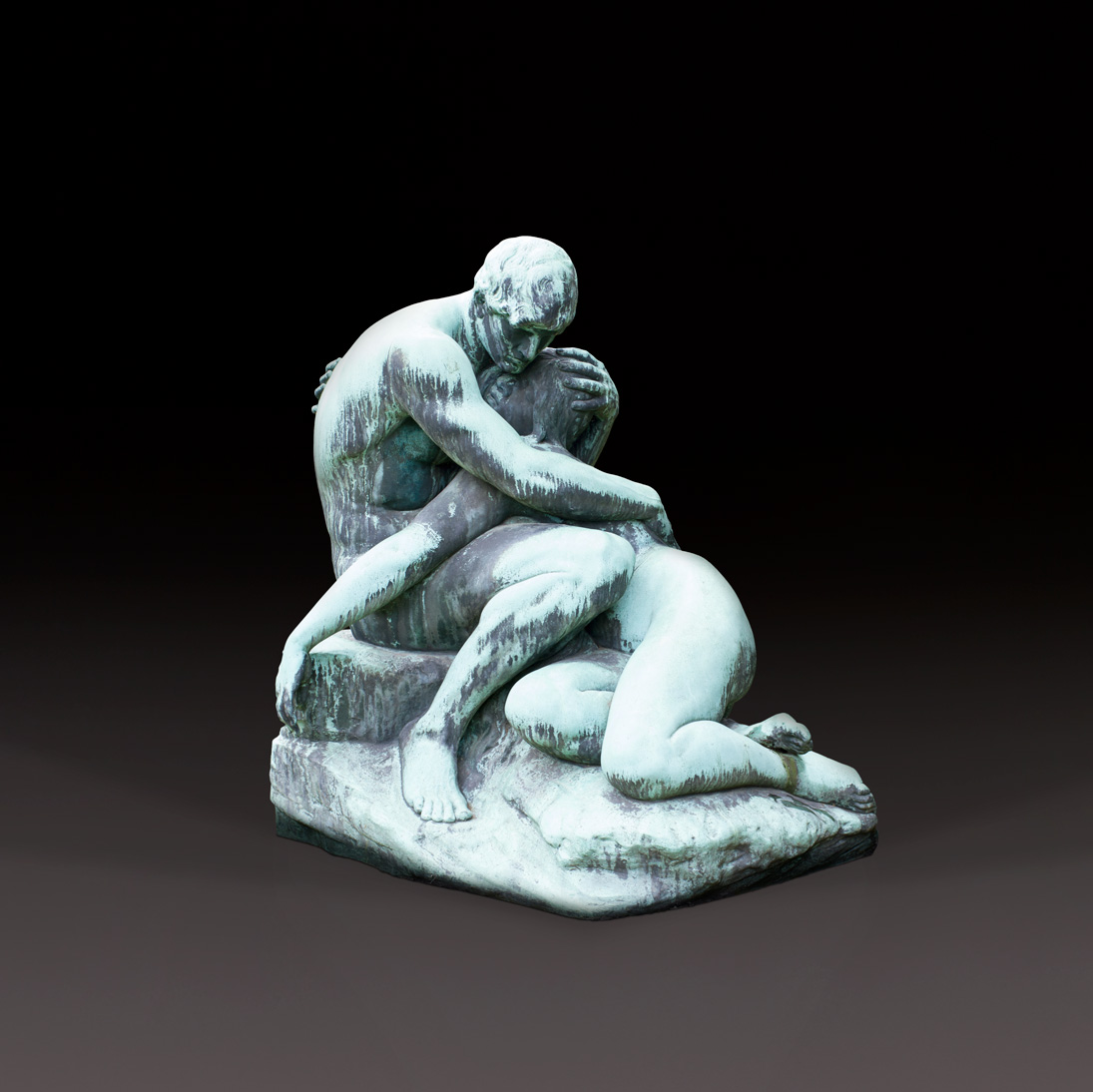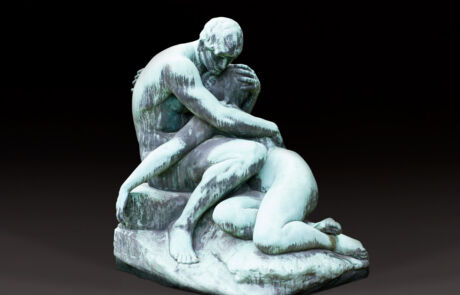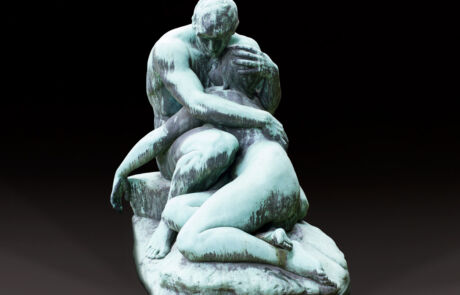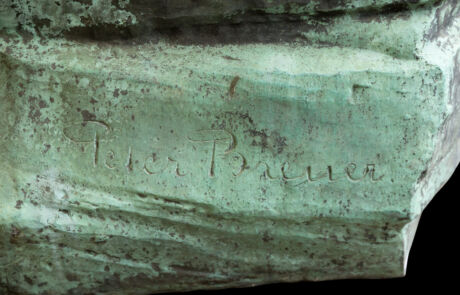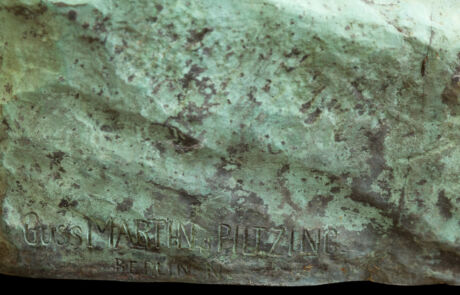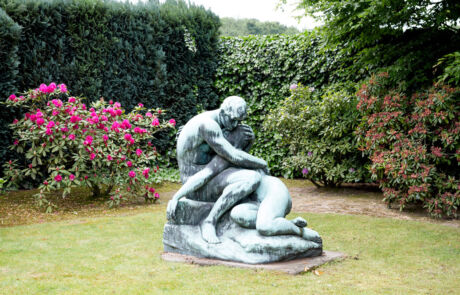Auction 61 / Lot 43
Title
ADAM AND EVE
Artist
PETER BREUER
Artist Data
1856 Cologne - 1930 Berlin
Origin
1898
Technique
Bronze, dark partinated
Dimension
H. 150 cm
Reserve price
Hammer price
Description
Inscribed 'Peter Breuer' and 'Guss Martin & Piltzing Berlin' on the back of the natural plinth. Traces of weathering on the patinated surface (partial verdigris). Provenance: Owned by the family of Dr. Edmund Rumpler (1872 - 1940) until after the Second World War. After 1945 private property in the Rhineland. Literature: Sibylle Einholz, Peter Breuer - Ein Plastiker zwischen Tradition und Moderne, Phil.Diss. FU Berlin 1984; P. Bloch / S. Einholz / J. von Simson (eds.), Ethos und Pathos. Die Berliner Bildhauerschule 1786 - 1914, Berlin 1990. 'The larger-than-life bronze group depicts the first human couple Adam and Eve. It shows the moment after the expulsion from paradise. Despite the narrative content, the religious theme is only marginally anecdotal. Slumped together and tightly embraced, the couple convey the deep despair of their situation. Adam holds the collapsed Eve protectively in his arms. The couple symbolically stands for human emotions and the love that binds them into a fate they must bear together. The mood of bleak despair can be read in the faces. The psychologising emotion, the agitation of the group and the painterly surface effect are typical means of neo-Baroque stylistic tendencies. The specimen shown here is the only bronze replica of the group ''Adam and Eve'' by Peter Breuer, which was made from the original plaster of 1894. It was made in 1898 at the Berlin foundry Martin & Piltzing, a company that excelled in large-scale castings for monuments. Until after the Second World War, the ''Adam and Eve'' group was owned by the family of Dr. Edmund Rumpler (1872 - 1940), an aeronautical engineer who was a friend of the sculptor. Rumpler made the bronze group available in 1936 for the exhibition ''Berlin Sculptors from Schlüter to Today''. Until the end, the work of art was privately owned. Adam and Eve' is considered Breuer's main work in the field of his autonomous genre works. As a work of early creation, it takes up neo-Baroque tendencies in sculpture, as represented by Breuer's mentor and patron, Reinhold Begas. While Breuer had already succeeded in 1891 with the statuette ''Spring'', a work of almost Art Nouveau character, the religious genre group ''Adam and Eve'', completed afterwards, can be understood as a reverence to the important colleague Begas, who involved the younger sculptor in several large-scale projects and thus considerably promoted Breuer's success. A first sketch of the work ''Adam and Eve'' is said to have been made as early as 1880. The first original-sized plaster version was awarded a ''Small Golden Medal'' at the Great Berlin Art Exhibition in 1894. The marble version of the same size, which was shown for the first time at the International Art Exhibition in Berlin in 1896, was awarded the ''Golden Medal'' in Munich in 1897, the ''Great Medal of Honour'' at the World Exhibition in Paris in 1900 and the ''Grand Prix'' at the World Exhibition in St. Louis in 1904. This only marble version can be traced back to 1907 in the artist's possession. As a purchase of the Düsseldorf Academy, it came to the city's Flora Garden in 1941, where it is still to be found today. Both the Berlin company Gladenbeck and Lauchhammer offered castings in reduced sizes. A whole series of these so-called shop bronzes have survived in private ownership. Peter Breuer was born in Cologne on 17 June 1856. An apprenticeship as a craftsman in his home town was followed by training at the Munich Academy in 1874 and studies at the Berlin Academy of Arts until 1879. From this time on, Breuer regularly participated in the academy exhibitions. Minor successes followed before he received his first public recognition in 1889 with the seated statuette ''Spring''. The collaboration on the Kaiser-Wilhelm-Nationaldenkmal with the appointment as ''Kgl. Preuss. Professor'' and the promotion by Reinhold Begas, enabled Breuer to rise and participate in the awarding of public commissions. Begas involved him in the ''Siegesallee'' project. The ''Small Golden Medal'' for the religious genre group ''Adam and Eve'' (1894) falls into this period. With the ''Large Golden Medal'' (1897), Breuer succeeded in joining the group of ''official'' artists. As a member of the Royal Academy of Arts, Breuer was appointed senator, a position he held until 1927. Breuer developed into a busy monument sculptor, whose most important monuments include the Bismarck for Breslau (1900), the Kaiser Wilhelm monument in Halle (1901) and the Lilienthal monument in Berlin-Lichterfelde (1914). The final point of his artistic development is realised in the Beethoven Monument for Bonn (1926). The small sculptures created in parallel also enjoyed great popularity. The sculptor's style ranges from neo-baroque influences of his early works to features of a developing modernism, which tend to reveal themselves in his oeuvre and make him a typical representative of the transitional generation. Breuer died on 1 May 1930 in Berlin.' We would like to thank Prof. Dr. Einholz, Berlin, for providing this catalogue contribution.
